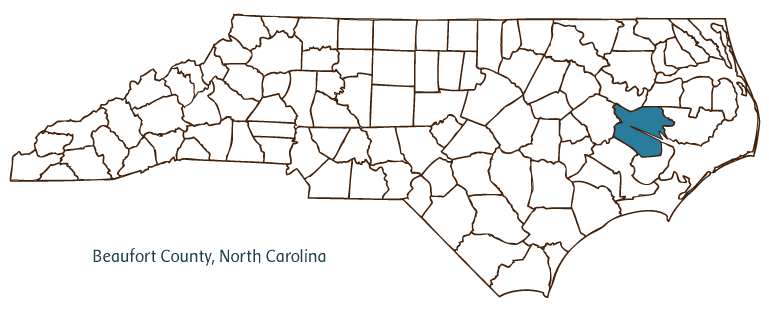Beaufort County Resources
- View All:
- Biographies
- Monuments
- locations
Copyright Notice: This article is from the Encyclopedia of North Carolina edited by William S. Powell. Copyright © 2006 by the University of North Carolina Press. Used by permission of the publisher. For personal use and not for further distribution. Please submit permission requests for other use directly to the publisher.

Beaufort County, located on Pamlico Sound in North Carolina's Coastal Plain region, was originally formed as Pamptecough Precinct, a part of Bath County, in 1705. In 1712 it took its present name from Henry Somerset, duke of Beaufort, one of the Lords Proprietors. Its county seat, since 1785, has been the city of Washington, founded in 1770s as Forks of the Tar and called Washington as early as 1776. Washington is believed to be the first town in the United States named for President George Washington. The county, rich in history and coastal traditions, also includes the town of Bath, North Carolina's oldest incorporated town, as well as Aurora, Belhaven, Chocowinity, Pantego, and Pinetown. In 2004 Beaufort County's population was estimated at 45,000.
As early as the 1580s, English explorers visited the lands that became Beaufort County, encountering the Tuscarora and other Indians who lived in the Pamlico River basin. The first permanent settlements were established in the 1690s, and Bath was incorporated in 1705. The area, at a junction of coastal and inland rivers, continued as a key center of growth for the Carolina colony. Washington, established by colonist James Bonner on his farm bordering the Tar/Pamlico River, became an important port in the late eighteenth century and, during the Revolutionary War, served as a strategic supply point for the Continental Army. Washington remained the economic and cultural center of the county, with a thriving shipbuilding trade, through the first half of the nineteenth century.
John Gray Blount (1752-1833), merchant and land speculator, kept his home in Washington. In April 1864 the city was devastated when a fire set by Union troops to burn a cache of naval stores blazed out of control and consumed much of the central district. Residents rebuilt the city after the war, only to see much of it destroyed again in a fire that swept through the town in September 1900. The city was rebuilt once more, and today the few remaining structures from the 1700s and early 1800s and the late Victorian architecture of the restored downtown district are preserved and listed on the National Register of Historic Places.
The fortunes of Beaufort County began to wane with the decline of the shipping trade in the early twentieth century, but it remains an important center for the state's seafood industry, with a number of commercial fishing enterprises located in Belhaven. Coastal and cultural heritage tourism also plays an important role in the local economy. Fossil beds on the southern banks of the Pamlico River are considered to be among the richest on the Atlantic Coast; prehistoric sharks' teeth and other fossils recovered from the beds are on display at the Aurora Fossil Museum. The county also holds an important place in North Carolina folklore. Edward Teach, known as the pirate Blackbeard, lived briefly in Bath and is said to have buried treasure in the county before being killed in a battle with British sailors at Ocracoke Inlet in 1718.
For an annotated history of the county's formation, with the laws affecting the county, boundary lines and changes, and other origin information, visit these references in The Formation of the North Carolina Counties (Corbitt, 2000), available online at North Carolina Digital Collections (note, there may be additional items of interest for the county not listed here):
County formation history: https://digital.ncdcr.gov/Documents/Detail/the-formation-of-the-north-ca...
Index entry for the county: https://digital.ncdcr.gov/Documents/Detail/the-formation-of-the-north-ca...
Additional resources:
Corbitt, David Leroy. 2000. The formation of the North Carolina counties, 1663-1943. https://digital.ncdcr.gov/Documents/Detail/the-formation-of-the-north-carolina-counties-1663-1943/3692099?item=4553233 (accessed June 20, 2017).
Beaufort County Government: http://www.co.beaufort.nc.us/
Washington Beaufort County Chamber of Commerce: https://www.wbcchamber.com/
DigitalNC, Beaufort County: https://www.digitalnc.org/counties/beaufort-county/
North Carolina Digital Collections (explore by place, time period, format): https://digital.ncdcr.gov
Image credits:
Rudersdorf, Amy. 2010. "NC County Maps." Government & Heritage Library, State Library of North Carolina.
Bangma, Peter. "Beaufort County." NCpedia. State Library of NC. 2006. https://www.ncpedia.org/geography/beaufort.